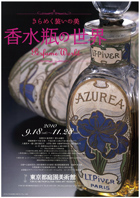18 September – 28 November, 2010
 The origins of the word “perfume” can be traced to a term denoting pleasant-smelling smoke from a burning substance. It originally referred to the incense burned as offerings to convey a worshipper’s prayers to the gods. Subsequently, it came to refer to the perfumes and fragrances treasured by the nobility.
The origins of the word “perfume” can be traced to a term denoting pleasant-smelling smoke from a burning substance. It originally referred to the incense burned as offerings to convey a worshipper’s prayers to the gods. Subsequently, it came to refer to the perfumes and fragrances treasured by the nobility.
To members of the upper classes, the lavishly decorated bottles in which perfume was stored were an expression of the high value assigned to perfume. Since the perfume itself was regarded as a work of art, they demanded that its containers be supremely beautiful as well. In designs that vary from age to age, perfume bottles themselves became outstanding examples of works of decorative art.
The exhibits included 280 works from the collection of the Umi-Mori Art Museum in Hiroshima, ranging from early alabaster and glass bottles to Sèvres, Meissen, and Chelsea porcelain, Baccarat and Lalique glass, and bottles designed for Dior and other haute couture houses. This exhibition also included a special exhibit of Fabergé and Boucheron perfume bottles, together with prints and paintings from the Petit Palais, Musée de Beaux-Arts in Paris. A total of 350 works were displayed, tracing the history and culture of perfume.